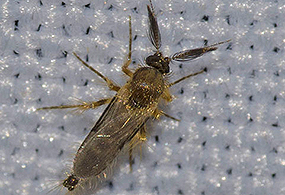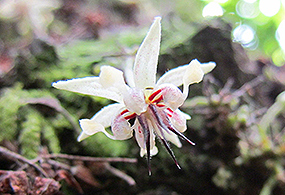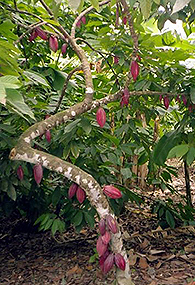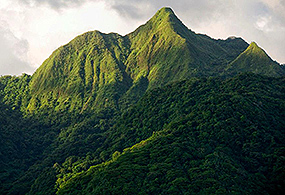Every bite of chocolate we eat starts off as seeds in pods that grow on Theobroma cacao, a tree whose name translates to "cacao, food of the gods." Enter chocolate midges—without the midges, there would be no chocolate!
Creating "food of the gods"

Brian V. Brown/Encyclopedia of Life
Every bite of chocolate we eat starts off as seeds in pods that grow on Theobroma cacao, a tree whose name translates to “cacao, food of the gods.” Cacao is a small tropical tree that grows in the shade of larger trees in Central America, South America, Africa, and Asia. The trees’ flowers grow directly from the trunks and lower branches, and, when pollinated, produce the prized seed pods. The flowers are small, white, convoluted, face downwards, and require tiny pollinators.
Enter chocolate midges—very small flies with long, complicated names: Ceratopogonidae, various species of Forcipomyia and Euprojoannisia. No bigger than the size of pinheads, midges seem to be the only creatures that can work their way into the intricate flowers to pollinate. They are most active in their pollination duties at dusk and dawn, in sync with the cacao flowers, which fully open right before sunrise. Without the midges, there would be no chocolate!
A Fly’s Point of View

NPS
Today cacao trees are often is cultivated in open plantations, rather than in the humid shade of their natural rainforest habitat. Plantation cacao produces many flowers, but on average, only three out of 1000 flowers become pollinated and produce seed pods. From a midge’s point of view, planation cacao does not equal natural rainforest cacao!
The native habitat of chocolate midges is dense, shady rain forests, so the midges seldom seek the sunnier, unnatural arrangement of cacao trees in commercial plantations for pollination. Also, within commercial plantations, the time of peak flower abundance is out of sync with the peaking of midge populations. To make matters even less attractive to the midges, wild cacao flowers have more than 75 distinct aroma ingredients, while cultivated cacao flowers have only a few.
Low Pollination equals Unsatisfied Chocolate Cravings

Mark Kesl
Like many other pollinators, chocolate midges suffer from loss of habitat, as large tracts of natural rainforest are replaced by cacao plantations.
Approximately one third of the world crop of cacao is lost every year because of plant pests and diseases. Pesticides and herbicides may be used to combat crop loss, resulting in contaminated waters and soils and an increased loss of biodiversity.
In some parts of the world, efforts are being made to grow cacao on small farms nestled in and around natural rain forest ecosystems to address these problems, salvage a $50 billion-a-year industry, and keep chocolate itself from becoming endangered!
Chocolate midges and National Parks

NPS
Most American national parks do not have the right habitat to support either cacao or chocolate midges. The National Park of American Samoa is an exception, providing the right “ingredient” to make chocolate: tropical rainforest.
Several NPS sites have established “sister park” relationships with parks in other countries to address common resource concerns. Chocolate midges and other pollinators exist in several of these sister parks, including Parque Nacional Laguna del Tigre in Guatemala (sister park to Big Cypress National Preserve);Brazil’s Parque Nacional do Pantanal Matogrossense (sister park to Everglades National Park), and Monteverde Cloud Forest Reserve and Parque Nacional Corcovado in Costa Rica (sister parks to Rocky Mountain National Park and St. Croix River National Scenic Waterway, respectively).
